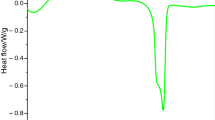Conclusions
Flexural fatigue of uniaxially and biaxially stressed IPN/glass mat composites was investigated using four point bend (4PB) and concentrically loaded (CL) specimen geometries. Regions of nearly constant bending moment between the inner spans of a 4PB beam and within the inner annulus of a CL circular plate yield quasi-uniform uniaxial and biaxial stress, respectively, on the tensile faces. The specimen dimensions were optimized for both loading geometries to give: (1) reduced specimen deflection through maximizing the ratio of the induced tensile stresses to the applied load, (2) minimized contact stresses by maximizing the induced stress with respect to the unit contact load, and (3) a large material volume exposed to the maximum cyclic stress (i.e., statistical fracture initiation).
A power model was used to analyze the fatigue data for the 4PB and CL specimens. Both IPN composite materials studied fatigued more rapidly under the more severe loading conditions imposed by the CL specimen geometry.
Fractography revealed that debond fracture was the dominant damage process for both geometries. The initial debond cracks were uniformly distributed throughout the stressed regions, confirming the presence of nearly uniform tensile stress. Damage localization followed after further cycling and was characterized by a locally high debond fracture density, fiber fracture, and always occurred where several glass strands crossed near the specimen surface. Final specimen failure resulted from the preferential growth of dominant cracks through the specimen thickness.
Similar content being viewed by others
References
A. Adembri and C. Lesca, ‘Preparation and Characterization of IPN Systems with Unsaturated Polyester’, SIR Industriale, Montecatini Group, Milano, Italy.
J. F. Mandell, ‘Fatigue behavior of short fiber composite materials’, inFatigue of Composite Materials, K. L. Reifsnider (ed.), Elsevier, New York, 1990, p. 231.
J. F. Mandell, F. J. McGarry, D. D. Huang, and C.G. Li,Polym. Compos. 4, 1983, 32.
S. P. Timoshenko and S. Woinowsky-Krieger, ‘The Theory of Plates and Shells’, McGraw Hill, New York, 1989.
G. D. Sims, Versailles Project on Advanced Materials and Standards (VAMAS), NPL Report DMA (A) 180, April 1989.
M. J. Owen, in ‘Short Fiber Reinforced Composite Materials’, B. A. Sanders (ed.), ASTM STP 772 (1982) 64.
M. J. Owen, J. R. Griffiths, and M. S. Found, in ‘Proc. 1975 Int. Conf. on Composite Materials, Vol. 2’, E. Scala and E. Anderson (eds.), AIME/TMS, New York, 1976, p. 917.
M. M. Yamashita, C. T. Hua, and P. Stumpff, ASM International, Paper 8822-010, 1988.
Author information
Authors and Affiliations
Rights and permissions
About this article
Cite this article
Stupak, P.R., D'Amore, A., Rigale, F. et al. Uniaxial and biaxial flexural fatigue of glass reinforced inter-penetrated network polymer composites. Appl Compos Mater 1, 19–33 (1994). https://doi.org/10.1007/BF00567209
Received:
Accepted:
Issue Date:
DOI: https://doi.org/10.1007/BF00567209




